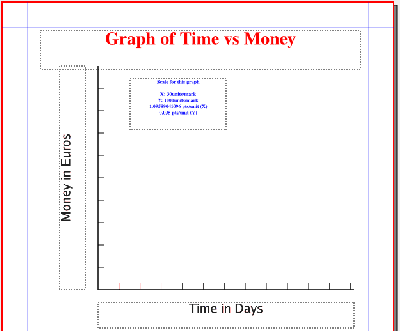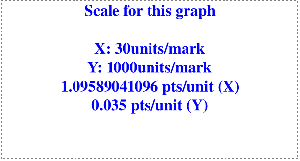Creating a Graph, Part 2: Difference between revisions
No edit summary |
|||
| Line 1: | Line 1: | ||
This page will start with the script graph.py, and create a new graph2.py to add some additional features. | |||
[http://wiki.scribus.net/index.php/Automatically_Creating_a_Graph] | |||
|}This page will start with the script graph.py, and create a new graph2.py to add some additional features. | |||
'''graph.py''' makes a simple graph with X and Y axes, labels for the axes, and a title. With '''graph2.py''' we will add the ability to assign a scale to the axes, make user-defined tick marks, and then give some feed back about the typographic features of this graph. | '''graph.py''' makes a simple graph with X and Y axes, labels for the axes, and a title. With '''graph2.py''' we will add the ability to assign a scale to the axes, make user-defined tick marks, and then give some feed back about the typographic features of this graph. | ||
Revision as of 19:57, 18 May 2006
[1] |}This page will start with the script graph.py, and create a new graph2.py to add some additional features.
graph.py makes a simple graph with X and Y axes, labels for the axes, and a title. With graph2.py we will add the ability to assign a scale to the axes, make user-defined tick marks, and then give some feed back about the typographic features of this graph.
New requestors
xrange = int(scribus.valueDialog('Maximum X Scale', 'Enter Top X Value\n(Scale)'))
xmark = int(scribus.valueDialog('Tick Mark Interval', 'Enter X Interval for Tick Marks'))
The first asks for the value for the total X axis in the units of the graph (no need to name to units here), which we need to convert to an integer. The second asks for the number of units between tick marks on the X axis scale.
From this we can calculate a typographic scale for our graph, using the fact that we have set the width of the graph with the variable xaxis:
xscale = xaxis/xrange # this give you data units per axis value in points
Now we can generate the tick marks, using a while loop:
while (xtick < (xorigin + xaxis)):
xt = scribus.createLine(xtick, yorigin, xtick, yorigin - 10)
scribus.setLineWidth(t, xt)
scribus.setLineColor(color, xt)
scribus.setFillColor(color, xt)
xtick = xtick + xmark * xscale
These tick marks will appear above the axis line, but could as easily appear below -- change -10 to +10.
Now, as an aid to the Scribus user, let's add a text box that will help with the page measurements for adding other features with Scribus:
caption = "Scale for this graph\n\n" "X: " + str(xmark) + "units/mark\n" + "Y: "
caption = caption + str(ymark) + "units/mark\n" + str(xmark) + " units = "
caption = caption + str(xscale * xmark) + " pts (X)\n" + str(ymark) + " units = "
caption = caption + str(yscale * ymark) + " pts (Y)"
# These caption statements can be combined to one line
S = scribus.createText(200, 120, 150, 80)
scribus.setTextColor("Blue", S)
scribus.setText(caption, S)
scribus.setTextAlignment(1, S)
scribus.setFont("Nimbus Roman No9 L Bold", S)
scribus.setFontSize(8, S)
Now, the Results
So, here is an example of the final result:
| And here is the information we can use in Scribus (detail of the small text frame above): |
Script: graph2.py
#!/usr/bin/env python
# File: graph2.py
# originally 2006.05.17
# this version 2006.05.18
# creates basic graph with axis labels
import scribus
xorigin = 150 # x-origin of graph
yorigin = 450 # y-origin of graph
xaxis=400 #x axis length
yaxis=350 #y axis length
color="Black"
a = 1.5 # width of lines
t = 0.8 # width of scale markers
if scribus.haveDoc():
title = scribus.valueDialog('Title','Enter Title')
xlabel = scribus.valueDialog('X-axis Label','Enter X-Label')
ylabel = scribus.valueDialog('Y-axis Label','Enter Y-Label')
xrange = int(scribus.valueDialog('Maximum X Scale', 'Enter Top X Value\n(Scale)'))
xmark = int(scribus.valueDialog('Tick Mark Interval', 'Enter X Interval for Tick Marks'))
xtick = xorigin
xscale = xaxis/xrange # this give you data units per axis value in points
yrange = int(scribus.valueDialog('Maximum Y Scale', 'Enter Top Y Value\n(Scale)'))
ymark = int(scribus.valueDialog('Tick Mark Interval', 'Enter Y Interval for Tick Marks'))
ytick = yorigin
yscale = yaxis/yrange # this give you data units per axis value in points
scribus.setRedraw(1)
scribus.setUnit(0)
d = scribus.createLine(xorigin,yorigin,xorigin+xaxis,yorigin)
scribus.setLineWidth(a, d)
scribus.setLineColor(color, d)
scribus.setFillColor(color, d)
e = scribus.createLine(xorigin,yorigin,xorigin,yorigin-yaxis)
scribus.setLineWidth(a, e)
scribus.setLineColor(color, e)
scribus.setFillColor(color, e)
xtick = xtick + xmark * xscale
ytick = ytick - ymark * yscale
while (xtick < (xorigin + xaxis)):
xt = scribus.createLine(xtick, yorigin, xtick, yorigin - 10)
scribus.setLineWidth(t, xt)
scribus.setLineColor(color, xt)
scribus.setFillColor(color, xt)
xtick = xtick + xmark * xscale
while (ytick > (yorigin - yaxis)):
yt = scribus.createLine(xorigin, ytick, xorigin + 10, ytick)
scribus.setLineWidth(t, yt)
scribus.setLineColor(color, yt)
scribus.setFillColor(color, yt)
ytick = ytick - ymark * yscale
T = scribus.createText(60, 45, 500, 60)
scribus.setTextColor("Red", T)
scribus.setText(title, T)
scribus.setTextAlignment(1, T)
scribus.setFont("Nimbus Roman No9 L Bold", T)
scribus.setFontSize(28, T)
XL = scribus.createText(xorigin, yorigin + 20, 400, 40)
scribus.setText(xlabel, XL)
scribus.setTextAlignment(1, XL)
scribus.setFont("Luxi Sans Regular", XL)
scribus.setFontSize(20, XL)
YL = scribus.createText(90, 450, 350, 40)
scribus.setText(ylabel, YL)
scribus.setTextAlignment(1, YL)
scribus.setFont("Luxi Sans Regular", YL)
scribus.setFontSize(20, YL)
scribus.rotateObject(90,YL)
caption = "Scale for this graph\n\n" "X: " + str(xmark) + "units/mark\n" + "Y: "
caption = caption + str(ymark) + "units/mark\n" + str(xmark) + " units = "
caption = caption + str(xscale * xmark) + " pts (X)\n" + str(ymark) + " units = "
caption = caption + str(yscale * ymark) + " pts (Y)"
# These caption statements can be combined to one line
S = scribus.createText(200, 120, 150, 80)
scribus.setTextColor("Blue", S)
scribus.setText(caption, S)
scribus.setTextAlignment(1, S)
scribus.setFont("Nimbus Roman No9 L Bold", S)
scribus.setFontSize(8, S)
scribus.redrawAll()

